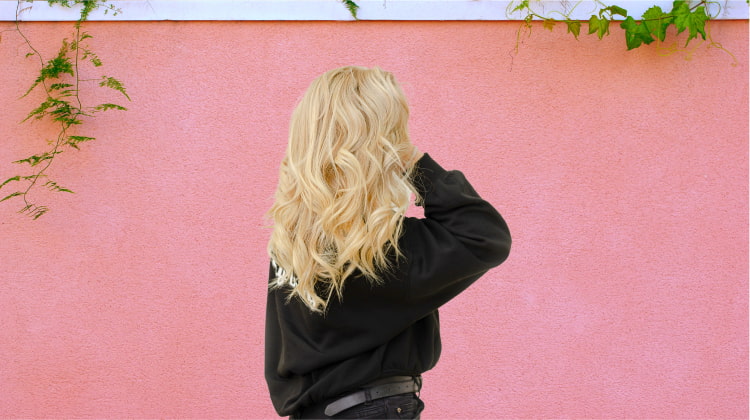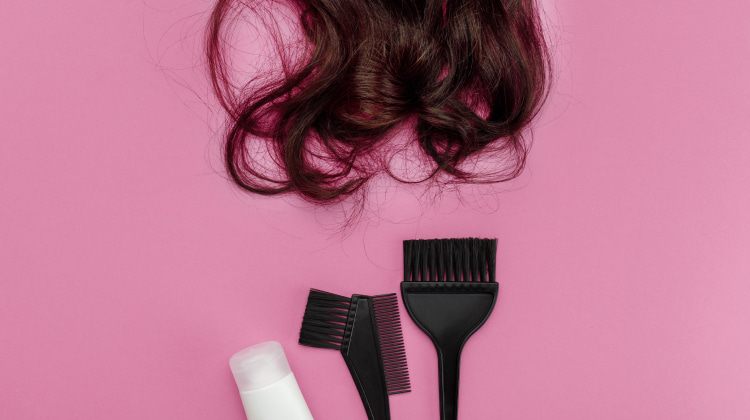
How are you doing, hair enthusiasts? Are you wondering if it's possible to bleach your hair after you've already dyed it? Or perhaps you're looking for ways to lighten your colored tresses? If so, you're in the right place!
In this article, we'll delve into the world of hair dye and bleaching, answering all your burning questions about the process. We'll discuss whether you can bleach over permanent hair dye, how soon you can do it, and the best methods to lighten your dyed locks. We'll even explore alternatives to bleaching for removing permanent hair dye.
So, whether you're considering lightening your dark-colored hair or looking to add some highlights, we've got you covered. Grab your hairbrush, and let's get started!
Can You Bleach Over Permanent Hair Dye?
The answer is yes, you can bleach over permanent hair dye, but it's essential to approach it with caution and follow specific steps(1) to ensure the best results. Bleaching your hair can be a game-changer for your overall look, but there are a few aspects to consider.
Can You Bleach Over Box Dyed Hair?
The short answer is yes, you can bleach over box-dyed hair. However, box dyes often contain strong chemicals, and the process of bleaching can be quite harsh on your hair. You might experience uneven color or even damage if you're not careful.
It's recommended to consult with a professional hairstylist or colorist to help you navigate the process, especially if you have little to no experience with bleaching.
Can You Bleach Over Permanent Black Hair Dye?
Again, yes, you can bleach over permanent black hair dye, but it's a process that requires extra care and attention. Bleaching black hair may take multiple sessions to achieve the desired result, as black hair dye is notoriously difficult to lift.
It's essential to be patient and avoid over-processing your hair, which could lead to severe damage. A professional colorist will be able to assess your hair's condition and develop a plan to lighten it safely and effectively.
When Not to Bleach Over Permanent Dye?
There are some situations in which bleaching over permanent dye may not be the best option. If your hair is already damaged, dry, or brittle, the bleaching process could exacerbate these issues(2) and leave your hair in worse shape.
Also, if you've recently applied henna or metallic dyes to your hair, bleaching could lead to unwanted reactions and unpredictable results. In these cases, it's best to consider alternative methods or seek professional advice before proceeding with bleaching.
How Soon Can You Bleach Hair After Permanent Dye?
Wait at least two weeks before bleaching your hair after using permanent dye. It's essential to give your hair enough time to recover from the dyeing process before subjecting it to further chemical treatments like bleach. So, why is waiting so important?
The waiting period allows your hair to regain some of its natural oils, which helps protect it during the bleaching process. Additionally, during this time, you should focus on caring for your hair by using deep conditioning treatments, hydrating masks(3), and avoiding heat styling tools, as these can cause further damage.
However, keep in mind that every person's hair is different, and the ideal waiting period may vary depending on your hair's condition, texture, and history of chemical treatments. If your hair is already damaged or prone to breakage, it may be best to wait even longer or consult a professional hairstylist for personalized advice.
Remember, healthy hair is key to achieving the best results when bleaching, so patience and proper care are crucial.
How to Use Bleach to Lighten Dyed Hair

Lightening dyed hair with bleach can be a delicate process, but if you follow the right steps, you can achieve stunning results. Here's a step-by-step guide on how to use bleach to lighten your dyed hair:
Do a Strand Test
Before applying bleach to your entire head, it's crucial to perform a strand test to check how your hair will react to the bleach. Mix a small amount of bleach according to the manufacturer's instructions and apply it to a small, hidden section of hair. Observe the color lift and any potential adverse reactions to ensure it's safe to proceed.
Prepare Your Hair
Make sure your hair is clean and free of any styling products. It's also a good idea to avoid washing your hair immediately before bleaching, as the natural oils can provide some protection(4) to your scalp and hair.
Mix The Bleach
Follow the manufacturer's instructions to mix the bleach powder and developer. The developer, usually available in different volumes (e.g., 10, 20, 30, or 40 volume), determines the lifting power of the bleach. Lower volume developers are gentler on the hair, while higher volumes offer more lifting power but can be more damaging.
Be sure to use a non-metallic bowl and a brush to mix and apply the bleach. Stir the mixture well until it reaches a smooth, creamy consistency.
Section Your Hair
Divide your hair into four equal sections to ensure even application. Start by parting your hair down the middle from the forehead to the nape of your neck, creating two halves. Then, part each half horizontally from ear to ear, creating a total of four sections. Clip each section out of the way using hair clips while you work on one section at a time.
Apply the Bleach
Wearing gloves, start applying the bleach mixture to your hair using the brush. Begin at the mid-lengths and work your way down to the ends, leaving the roots for last. This is because the heat from your scalp will process the bleach faster, and you want to avoid over-processing the roots.
Time the Process
Keep an eye on the clock and follow the manufacturer's recommended processing time, which usually ranges from 15 to 45 minutes. Processing time may vary depending on the desired level of lightness and the starting hair color. Check your hair periodically to monitor the color lift and avoid leaving the bleach on for too long.
Rinse and Condition
Once the desired level of lightness is achieved, rinse the bleach from your hair thoroughly with lukewarm water. Follow up with a deep conditioning treatment to restore moisture and nourishment to your hair.
Remember, bleaching can be a risky process, especially for inexperienced individuals. If you're unsure about any part of the process or concerned about damaging your hair, it's always best to consult a professional hairstylist or colorist for guidance.
Alternatives to Bleach for Removing Permanent Hair Dye
Bleaching isn't the only option for removing or lightening permanent hair dye. There are alternative methods that can be gentler on your hair while still providing effective results. Let's take a look at some popular alternatives:
Color Removers
Hair color removers are specifically designed to strip the hair of artificial pigment. By breaking down the dye molecules, these products allow them to be washed out of your hair. Keep in mind that color removers may not restore your hair to its original color, and they can be drying, so follow up with a deep conditioning treatment.
Vitamin C Treatment
A DIY option for lightening dyed hair is using a vitamin C treatment. Crush a few vitamin C tablets and mix them with a clarifying shampoo to form a paste. Apply the mixture to damp hair, massage it in, and leave it for about 30-60 minutes before rinsing it out. This method can help gently lift the color, but results may vary.
Baking Soda and Shampoo
Another at-home method is mixing equal parts baking soda and clarifying shampoo to create a paste. Apply the mixture to your damp hair and let it sit for about 30 minutes. Rinse thoroughly and condition your hair. This technique can be drying, so it's essential to follow up with a nourishing conditioner or hair mask.
Hair Color Correctors
These products are designed to neutralize unwanted tones in your hair. For example, if your hair has turned too warm or brassy, a purple or blue toning shampoo can help counteract the unwanted hues. These correctors won't remove the color entirely but can help achieve a more desired shade.
Salon Services
If you're not confident about tackling hair color removal at home, consider consulting a professional hairstylist or colorist. They can offer specialized treatments, such as color correction or highlights, to help remove or blend out the unwanted color while minimizing damage to your hair.
Remember to consult a professional if you're unsure about any hair color removal process or if your hair has been through multiple chemical treatments. They can help guide you toward the best method for your specific hair type and color situation.
Final Thought
Deciding whether to bleach over permanent hair dye is a personal choice that depends on your hair type, color, and desired outcome. It's essential to approach the process with caution and be aware of the risks involved.
Give yourself enough time between dyeing and bleaching, follow proper application techniques, and consider alternatives if bleaching isn't the best option for your hair. So, go ahead and explore the possibilities for a stunning new look in 2023!
Frequently Asked Questions
Can you bleach over semi permanent hair dye?
Yes, you can bleach over semi-permanent hair dye. However, since semi-permanent dye fades gradually, it's better to wait until most of the color has washed out to minimize potential damage and uneven color results.
Will bleach lift permanent hair dye?
Yes, bleach will lift permanent hair dye, but the process may require multiple sessions, especially for darker colors. It's crucial to approach bleaching with caution to avoid damage and achieve the desired lightness.
What happens when you put bleach on permanent hair dye?
When bleach is applied to permanent hair dye, it breaks down the dye molecules and lightens the color. Results can vary depending on the hair's initial color, the bleach's strength, and the processing time.
Should I remove permanent hair color before bleaching?
It's not necessary to remove permanent hair color before bleaching, but waiting for some time between the dyeing and bleaching processes is essential to minimize damage and allow the hair to recover.
How can I lighten my permanent hair color?
You can lighten permanent hair color by bleaching, using hair color removers, or trying alternative methods like a vitamin C treatment or a baking soda and shampoo mixture. Consult a professional for the best results.
References
1. Madnani, N. (2013). Hair cosmetics. Indian Journal of Dermatology, Venereology and Leprology, {online} 79, p.654. Available at: https://ijdvl.com/hair-cosmetics/.
2. JEONG, M.-S., LEE, C.-M., JEONG, W.-J., KIM, S.-J. and LEE, K.-Y. (2010). Significant damage of the skin and hair following hair bleaching. The Journal of Dermatology, {online} 37(10), pp.882–887. doi:https://doi.org/10.1111/j.1346-8138.2010.00916.x.
3. Helen, I., Hadinoto, I., Hadisoewignyo, L. and Soegianto, L. (2011). Effect of Various Concentration of Vegetable Protein in Hair Mask on The Hair Texture. Indonesian Journal of Cancer Chemoprevention, {online} 2(1), p.159. doi:https://doi.org/10.14499/indonesianjcanchemoprev2iss1pp159-168.
4. IMAI, T. (2011). The influence of hair bleach on the ultrastructure of human hair with special reference to hair damage. Okajimas Folia Anatomica Japonica, {online} 88(1), pp.1–9. doi:https://doi.org/10.2535/ofaj.88.1.

.jpg)
.jpg)
.jpg)
.jpg)
.jpg)
.jpg)
.jpg)
.jpg)
.jpg)
.jpg)